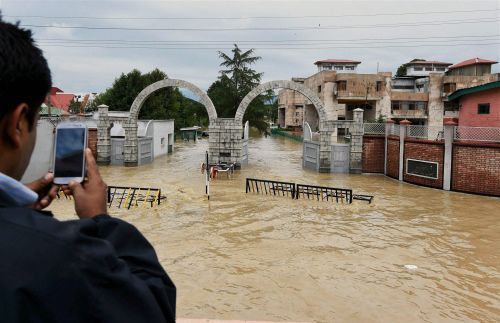 'For lakhs of people in the flood-afflicted state, battling against the elements is taking a huge toll. This is the time of the year that apples ripen, rice starts being harvested and preparations start in full swing to put aside some of the food stocks for the long winter months ahead.'
'For lakhs of people in the flood-afflicted state, battling against the elements is taking a huge toll. This is the time of the year that apples ripen, rice starts being harvested and preparations start in full swing to put aside some of the food stocks for the long winter months ahead.'
'At this moment, though, people there believe if they can succeed in coming out of this calamity in one piece they will have won the war,' says Rashme Sehgal.
It is too early to make an estimation of the death and devastation that have gripped Jammu and Kashmir. Over 200 dead and many lakhs displaced from their homes. Several thousand villages and towns remain submerged under water. With vast swathes of crops ruined, financial losses are expected to run into thousands of crores of rupees.
India's northern-most state was completely unprepared for this flood fury, with the Central Water Commission responsible for flood forecasting having no advisories in place for this key state. As a result, while on September 3, Srinagar was declared rainfall deficit with 308 mm, on September 5 and 6, the quantum of rainfall had jumped phenomenally to 558 mm.
The result of this heavy downpour was that the Jhelum, which flows through Srinagar, broke its embankments leading to water levels rising up to 15 feet in the city. There was heavy flooding in other rivers in the state, including the Tawi, Chenab, Lidder and Sindh, resulting in unprecedented flooding in the key cities of Jammu, Pathankot, Rajouri, Anantnag, Pulwama and Kupwara.
The problem is compounded by the fact that all the water channels, including smaller streams and rivulets that acted as a sponge to absorb excess flood water, have in the past two decades been encroached upon. Illegal constructions have clogged these drainage channels, resulting in river water laying waste entire cities. Srinagar's traditional waterways have been destroyed, giving place to roads.
Sunita Narain, heading the Centre for Science and Environment, has repeatedly warned that India remains extremely vulnerable to climate change.
'Every year, we face extreme weather events in the form of floods and cyclones which unleash havoc and result in huge revenue losses. And the Himalayan region is especially afflicted. According to the United Nations Intergovernmental Panel on Climate Change report, global warming will see changes in the Himalayan region with the number of rainy days in the Himalayan region in the 2030s expected to increase by 5, 10 days on an average, and the intensity of rainfall also expected to rise,' said Narain.
An abnormal amount of untimely rainfall was responsible for the Uttarakhand disaster in 2013 which resulted in the death of over 10,000 people.
Professor Surya Prakash, associate professor of National Institute of Disaster Management, travelled over 1,000 kilometres in the flood- and landslide-hit areas of Uttarakhand between June 22 and 24, 2013. He arrived at the conclusion that the abnormally high amount of rain (more than 400 per cent) swelled rivers, both in the upstream as well as downstream areas.
A huge quantity of water was released from the melting of ice and glaciers due to high temperatures during the months of May and June, causing the breaching of moraine dammed lakes in the upper reaches of the valley, particularly during the late evening on June 16 and June 17, killing several hundred persons, and trapping over one lakh pilgrims, with many more going missing.
Professor Prakash says the problem was compounded by the fact that the flood paths of the Alaknanda and the Mandakini rivers were blocked with illegal construction. Excess water saw the rivers change course and destroy buildings and other structures that had come up across many pilgrim towns including Kedarnath, Badrinath, Chamoli, Uttarkashi and Rudraprayag.
Experts and environmentalists believe a great deal of this resultant destruction was man-made. Indiscriminate development in the hill towns, with guest houses, hotels and all manners of illegal encroachment taking place along the rivers was a disaster waiting to happen.
Since 2002, a ban had been placed on the construction of buildings within 100 metres of the river bed, but this was observed more in the breach.
Even the Centre's declaration of the 100-km stretch along the Bhagirathi river from Gangotri to Uttarkashi as an 'eco sensitive zone' in 2012 saw both the Bharatiya Janata Party and Congress politicians leading delegations to the prime minister complaining that the move was opposed by the people in this state as it would adversely impact the economy.
Manoj Misra, heading the Yamuna Jiye Abhiyaan, in a letter sent on September 9, 2014, to Prime Minister Narendra Modi highlighted that Indian town planners and bureaucrats have learnt nothing from the Uttarakhand disaster. The letter warned that like in Uttarakhand, the town planners and bureaucrats of Srinagar have hardly bothered to factor in its life-line (the Jhelum) into the topography and locational reality of the city.
'Rather, they have allowed the flood plains to be encroached and developed with impunity so much so that the river, after it had entered the city, has precariously been chicken-necked into a narrow channel. So should it now be any surprise that high flows in the river resulted in the breaching of embankments breached and the city resultantly went under, like never before?' Misra's letter stated.
Misra also complained against the practice of building high embankments on river banks that on breach prove to be far more destructive than a gradual and uniform spread of flood waters over low bunds all along the banks.
Another matter of concern was the decision-makers and planners propensity to underplay climatic events as being transient and hence not worthy of serious consideration. He was making a direct reference to Congress leader Ghulam Nabi Azad's contention on a television debate (on September 8) that the 'monsoon in the valley is only for a short duration.'
'It may be for a short duration but climate change is witnessing many changes in the Indian monsoon which make it very intense. Therefore, any planning process, to be correct and wise, must provide for meeting the exigencies of an extreme case scenario, howsoever brief or remote might be its chance of occurrence,' Misra added.
It could be Kedarnath last year, Srinagar this year and any other city in the country tomorrow, Mishra maintained.
Professor Vikram Soni, a physicist at the Jamia Milia Islamia University in New Delhi, is very critical about the indiscriminate manner in which roads are being constructed in the Himalayas. "The Himalayas are a young mountain range comprising shale which is a very fragile stone, making it prone to landslides. We need to build very carefully but instead, all that is happening in these regions is a huge amount of dynamiting. This combined with deforestation has seen our rivers getting silted up and unable to contain excess rain water," he said.
The other major problem, hydrologists warn, is that the government has over the years favoured a consortium of IIT engineers over river engineers, but it is the river engineers who understand and know how to revive the health of our river systems.
Professor U K Choudhary, a river engineer who heads the M M Institute of Technology for Ganga Management in Varanasi, is in the forefront of this battle being waged against IIT engineers.
Speaking out against the construction of large dams, which has resulted in a huge increase in landslides, Professor Choudhary said, 'I have been warning successive governments that devastation by landslides is directly in proportion to the size and height of the dams being constructed in the Himalayas. This is happening because of pore pressure in rocks. When water is released from dams, the water inside the pores comes out with increasing pressure as was witnessed in the Uttarakhand floods last year.'
'The Himalayas are a fragile mountain range. Heavy landslides enhanced the drag forces which in turn increased the water velocity. Micro dams on the river would have been the right solution. They can help generate 3000 MW of electricity, apart from ensuring regular flow in the river,' he added.
This advice continues to fall on deaf ears. Successive dam lobbies have succeeded in edging out this advice. The construction of large dams has only served to enhance the destruction of our upper Himalayan region.
Meteorological monitoring, weather advance warning systems and post extreme-event rescue and relief operations will have to be upgraded to levels befitting the fragility of the Himalayan region's natural environment and ecology so that the state machinery is not caught napping as seems to be repeatedly the case.
Himanshu Thakkar of the South Asia Network on Dams, People and Rivers, questions why there is no accountability of the functioning of officials from the ministry of water resources.
'We hope the Central Water Commission will urgently include the flood vulnerable sites of Jammu and Kashmir in its flood forecasts, and also explain to the people of the state as well as the rest of the country why these sites were not included so far,' he pointed out.
Meanwhile, for lakhs of people in the flood-afflicted state, battling against the elements is taking a huge toll. This is the time of the year that apples ripen, rice starts being harvested and preparations start in full swing to put aside some of the food stocks for the long winter months ahead. At this moment, though, people there believe if they can succeed in coming out of this calamity in one piece they will have won the war.
Image: Flood-hit Srinagar. Photograph: PTI Photo.










